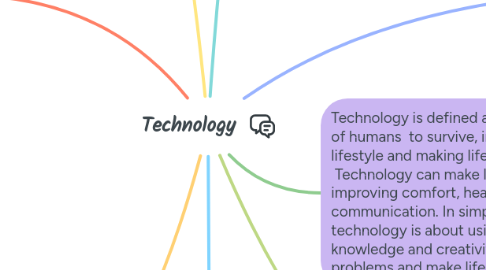
1. What I Thought Before
1.1. Invention of gadgets and machines, Landline telephones, fax machines
1.2. It was invented ti make life easy
1.3. Starting of stone age, invention of coal and instruments for hunting, need physical energy for operating.
1.4. Very expensive and It was seen as a luxury or symbol of modern life,
1.5. Share information
1.6. Entertainment
1.7. Invention of wheel
1.7.1. Helps in commuting from place to another
2. Why do we need Technology
2.1. “New technologies enhance education, productivity, and creativity, and help humans solve complex societal problems” (Schatzberg, 2006).
2.2. New technologies arise because older terms and tools (like ‘industrial arts’) become inadequate for new systems (Schatzberg, 2006,
2.3. Technology allows humans to expand their capabilities and adapt to changing global and digital environments” (Greelish, 2013).
2.4. For economic growth
2.5. To save time
3. What I thought After
3.1. to learn how technology shapes society, culture, and relationships
3.1.1. 1. Influences trends in fashion, music, and art 2.Influences buying habits (online shopping, e-commerce) 3. Affects privacy and security norms.
3.2. It builds skills for your future career
3.2.1. Prepares students for digital skills needed in future jobs
3.3. technology is part of daily life
3.4. positive and negative effects
3.4.1. negative effects
3.4.1.1. Can cause addiction
3.4.1.2. Loss of traditional skills (writing, navigation)
3.4.1.3. Reduces face-to-face interaction
3.4.1.4. Cyberbullying and online threats
3.4.1.5. Reduces physical activity
3.4.1.5.1. People become lazy,obese and many diseases spread.
3.4.1.6. Can cause stress or anxiety
3.4.1.7. Harm to the environment
3.4.2. positive effects
3.4.2.1. Makes communication easy
3.4.2.2. Helps in learning and education
3.4.2.3. Access to information anytime
3.4.2.4. Supports creativity
3.5. Connected to human behavior
3.5.1. It create habits or addictions of using gadgets (gaming, scrolling)
3.5.2. Affects emotions (likes, comments, online validation)
3.5.3. Changes cultural norms (trends, online behavior)
3.6. Potentially Risky:
3.6.1. Privacy issues (data leaks, personal info sharing)
3.6.2. Cyberbullying and online harassment
3.6.3. Spread of misinformation and fake news
3.6.4. Loss of traditional skills (writing, navigation)
3.7. Technology helps in education in educations centres.
3.7.1. Educational apps and games make learning fun
3.7.2. Reduces distance barriers (learning from anywhere in the world)
3.7.2.1. “Do our modern personal computing devices augment education? Have they lived up to what was foreseen in the past? Are they really helping teachers teach in the classroom? The perspective on this is first to ask whether the current educational practices are even using books in a powerful and educative way… I would say, to a distressing extent, the answer is ‘no.’” (Greelish, 2013, para. 13)
3.7.3. Helps teachers teach better (smartboards, presentations)
3.8. “Technology is no longer just a field of study; it is a practical and social phenomenon that impacts education, communication, and everyday life” (Greelish, 2013, para. 2).
4. References
4.1. Greelish, D. (2013, April 2). An interview with computing pioneer Alan Kay. TIME.
4.2. Schatzberg, E. (2006). Technik comes to America: Changing meanings of technology before 1930. Technology and Culture,
4.2.1. https://www.proquest.com/docview/198448721?accountid=3455&parentSessionId=I%2Bmx0LUY7GSGIKMSa37zXYsb0OL152bcyC6kxRlneDw%3D&sourcetype=Scholarly%20Journals
